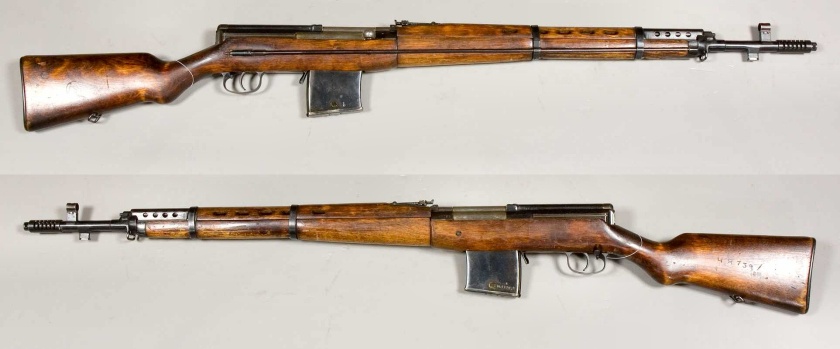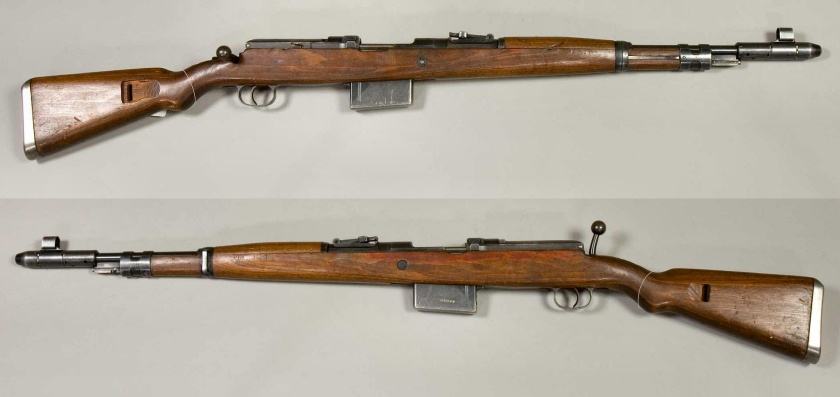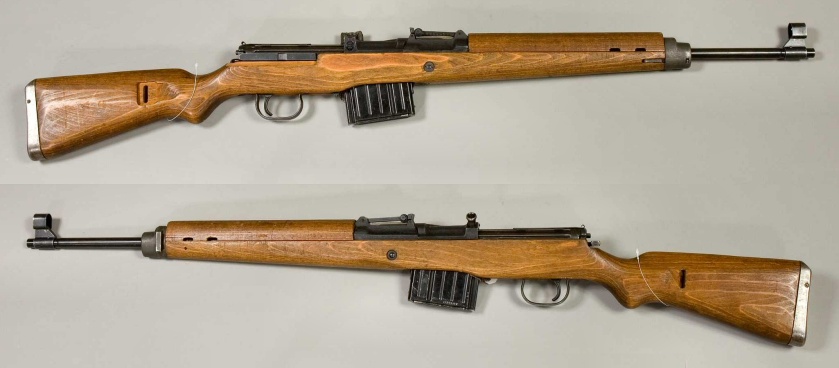Firstly, apologies for not posting in an age, I’ve been too busy building and not doing enough writing!

The Farquhar-Hill, an experimental British semi-automatic rifle.
Semi-automatic rifles were not a new technology by the Second World War, indeed they were available from the 1890s for those who really wanted to stay ahead of the curve: this not being all that long after the bolt-action/magazine combination was widely accepted. In spite of the seemingly obvious advantage of semi-automatic fire to the modern viewer, it took some time before it was widely adopted.

The 1907 Mondragon, a Mexican semi-automatic rifle. Interestingly Mexico was one of the first militaries to adopt this technology.
In the interwar years, most of the major nations experimented with semi-automatic rifles though only the US adopted it as their main rifle technology. That said they decided to sit out the first two years of the Second World War so had a bit more time to faff around.
The advent of the Second World War actually put back the adoption of semi-automatic rifles in Europe as there was a sudden need to re-arm without time for developing the new weapons. As a result, pretty well every nation went to war with the same rifles as they fought the Great War with.

Russian SVT-38
On the Eastern Front, German forces generally made good headway against the Soviets, thanks mostly to their major superiority in the air and mobility. One of the few sticking points was where they came up against troops armed with the SVT40 and SVT38 semi-automatic rifles.
As a result, the Wehrmacht put out a tender to German manufacturers for a semi-automatic rifle:
- No holes for tapping gas for the loading mechanism were to be bored into the barrel
- The rifles were not to have any moving parts on the surface
- In case the autoloading mechanism failed, a bolt action was to be included
The latter two make some sense even to modern eyes. The former was the result of paranoia that tapping gas for a reloading mechanism would sap the power of the bullet. The G41 used the ‘Bang’ system instead*. This system uses a ‘cup’ at the muzzle end to capture the blast and move the long operating piston. Sadly this system proved sensitive to dirt, hard to clean in the field and suffered from exposure to the corrosive chemicals used in primers of the era.
As a result of these problems among others, the G41 has earned a reputation of being possibly the most unreliable rifle of the era.

G41 (M), the particularly dreadful Mauser version of the G41. The swollen fore-end of the barrel is the cup that captures the muzzle blast. If you take this off it is full of lots of small parts.
This was not good enough for the Wehrmacht who had the rifle redesigned, using the Tokarev system for inspiration.
The result was the G43, a far more effective rifle, but the Germans still weren’t quite happy! G/Gewehr meant ‘long rifle’. At only two centimetres longer than the Kar98k the Germans felt It was too short to be ‘gewehr’ so in time renamed it K43.

Left and right sides of the G43. The scope rail is on the side of the receiver above the trigger in the top image.
Beyond this the rifle stayed much the same for the duration of the war with mainly minor alterations. A scope rail was added and featured on most production rifles so that a Zf4 scope could be used, though this was only special issue.

G43 with ZF4 scope mounted.
Over the next month or so I’ll be converting an M14 into a G43 lookalike, as usual sharing the results here! If you would be interested in an M14 to G43 or G41 conversion let us know on the usual email address: enquiries.vintageairsoft@gmail.com. You can also ‘like’ our Facebook page for interesting articles, web pages and incremental developments
Fun facts!
-
Later in the war some last-ditch K43s were produced to run on the 8mm Kurtz intermediate round and use Stg magazines
-
The Zf4 was the ONLY scope used by the Wehrmacht in WWII on the G43
-
German soldiers were instructed to make semi-automatic rifles unusable if capture was imminent, as a result many examples are found with broken butt stocks
*named after Søren H. Bang, the mechanism’s inventor


One thought on “G43: Hitler’s Garand”